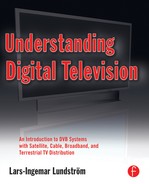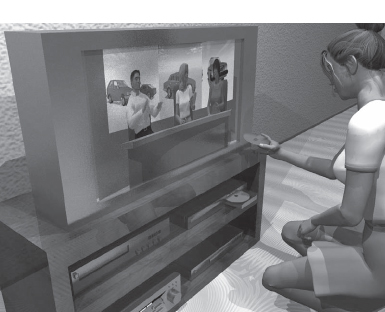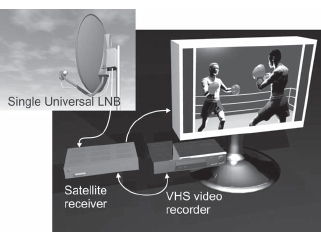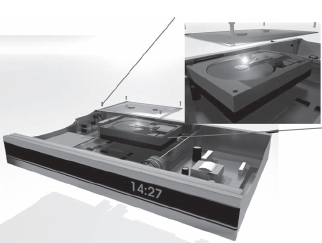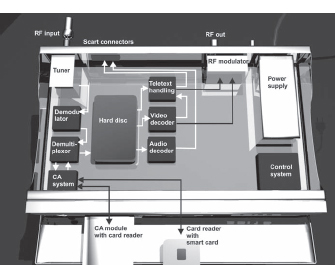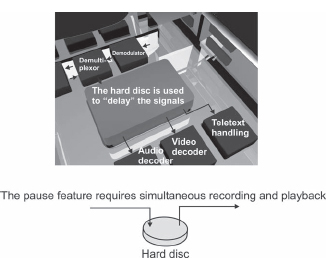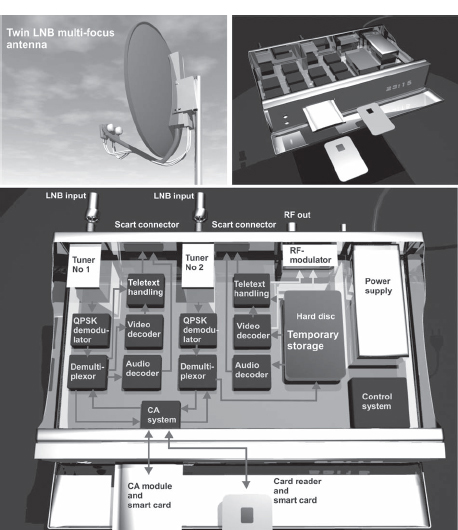10 |
Digital TV on Disc |
| CHAPTER |
FIGURE
10.1
The video recorder provided the viewer with a new freedom of viewing. Digital television combined with laser discs and hard discs give still more freedom and possibilities that are largely undiscovered.
The first video recordings ever made were stored on an old 78 rpm gramophone record. This was done sometime during the 1920s or 30s. The recorded signals were the same signals as were broadcast to the mechanical televisor, the predecessor of the TV. It wasn't until the 1950s that the first professional video recorders that could record “ordinary” electronic TV became useful.
By the end of the 1970s, it became possible for ordinary consumers to buy their own video recorder and watch recorded TV programs whenever they wanted. In 1979, I bought my first video recorder, the Philips Long Play VCR, which I had read had the best picture, best audio and the lowest price. But it all became wrong since the VCR cassettes were the wrong ones. After yet another Philips try, the Video 2000, undoubtedly the best system from a technical point of view, I finally bought my first VHS machine in 1985. This VCR even came with a video camera!. I was sure this would be the optimum solution. But still wrong! As a home video recorder, the device lacked many important features—it had no remote had to stand vertically, so I could not put it on a shelf. As a portable system, it was designed for body builders. If I wanted to go outside to record something with the video camera, I had to carry along the receiver, the timer system and the power supply (since the battery did not last that long).
From all this, I learned two things which I would like to share with you. Choose the standardized product even if it not the best from a technical point of view and do not underestimate devices specialized for different applications. Remember that a Swiss multifunctional knife does many things tolerably well but does not excel at anything. This also very much applies to electronics, where it might be better to buy two specialized pieces of equipment, rather than one that claims to do both.
SOLVING THE NEED FOR ANALOG RECORDED VIDEO
The VHS recorder is today a well-proven technology and fulfills all the basic needs of consumers. Since these needs are the same in the analog as well as in the digital world, we will dig deeper into this. There are three basic tasks most common for VHS recorders:
• Viewing pre-recorded movies and programs
• Time shifting or storing temporarily
• Storing permanently
FIGURE
10.2
The VHS cassette solves all the basic needs for recorded video.
Viewing Pre-Recorded Movies and Programs
In the early days of home video recorders, the availability of pre-recorded cassettes was very important. You might very well say that it was the large number of pre-recorded VHS movies that led to the victory of VHS in the standards war against Philips VCR, Video 2000 and the Sony Betamax systems that also existed in the early years of video recording equipment. Today, this need is handled by the DVD players. VHS still exists but is decreasing all the time and will soon disappear completely. It is probably only a matter of a few years before you don't find any more pre-recorded VHS cassettes in the shops.
Time Shifting or Storing Temporarily
The most common way to use a video recorder is for temporary storage or timeshift—recording a show at its original broadcast so you can watch it later, at a time that's more convenient for you. To be able to move a TV program to a more suitable time of viewing is very fundamental. For this reason, even the first video recorders had a built-in TV receiver, which made it possible to watch one TV channel while recording from another. Or you could record programs when you were not at home, had guests or other activities planned.
Though the earliest VHS recorders had tuners, they were only for terrestrial analog signals. As soon as you connect a satellite receiver, you will run into problems. You may let the satellite receiver be on at a selected channel while you program your video recorder to record from the scart connection at a certain hour. However this will only work if you only want to record from one single channel. This challenge led to the development of video timers to program the satellite receiver to jump between several channels according to the timer. Unfortunately you will have to program two devices—the satellite receiver and the video recorder. This is tedious and the risk making a mistake and recording the wrong thing is substantial. The manufacturers have made big efforts to synchronize the devices, but this has not proved to be very successful since you will have to have the right brands of equipment to get compatibility (using the data signals in the scart connector that were described in Chapter 9).
One of the worst problems in using the VHS recorder for temporary storage is that you must have an empty tape at home or know where on your existing tapes you have the empty space that you need for immediate use.
Storing Programs Permanently
The movies and films that we find important may be stored permanently on video cassettes. In this category, we find your home video recordings containing precious memories that you wish to save for future generations, such as weddings, birthday parties and graduations. However copying from 8 mm, Hi 8 or DV format (the media on which these events are most likely recorded) to a VHS tape will cause quality degradation. Further analog copying will make the quality problems even worse.
DIGITAL VIDEO RECORDING
Digital techniques provide completely new ways of recording video. The primary advantage is that the quality of the recorded material is much better that analog recording. The explanation for this lies in the possibilities of copying without any quality losses. Another advantage is that digital data is easy to store on discs rather than on tapes. This makes it much easier to find and to retrieve the recordings.
DVD: The Solution for Pre-Recorded Material
DVD stands for Digital Versatile Disc and the technology has quite quickly come to dominate the market for pre-recorded movies, since a wide range of titles are available and the audio and video quality is superior to anything ever available on cassettes. No matter how many TV channels you may have coming into your home, pre-recorded movies are very important. You are able to watch much newer movies and you can be much more specific when it comes to choosing what to watch. This is quite obvious, since there has always been a big market for renting VHS cassettes and DVD records.
A DVD record may be played hundreds or thousands of times without showing any signs of degradation. After about being played for just 20 times, the degradation of a video cassette recording is quite evident, which makes the DVD much more suitable for the renting business. What pushed the adoption of the DVD technology forward was also the fact that more and more people are buying home cinema systems. Only the DVD can provide the audio and video quality that is expected from such systems.
FIGURE
10.3
Today the DVD player is as common as the VHS recorder in most homes.
To record audio and video in digital format was a big challenge only a few years ago, primarily due to the enormous quantity of data that has to be stored if the signals are not efficiently compressed. To be able to record in digital format is very important to avoid the noise that is always involved and unavoidable in analog recording on tape.
The introduction of MPEG-2 made it possible to compress the video signals so DVDs could contain hours of video. As with DVB distribution, it become much easier to have several versions of subtitles going in parallel with the audio that also might be multilingual. There might also be different multichannel audio versions, such as Dolby Digital 2.0, Dolby Digital 5.1 and DTS 5.1 and higher levels of these formats stored in parallel on the discs. All these signals are completely separated from each other and there is no crosstalk whatsoever as is normal in analog systems. Of course all this is necessary to achieve high quality home cinema performance.
The DVD is closely related to the digital television system regarding the compression systems for audio as well as for video. You could say that they belong to the same era while the VHS recorder belongs together with the analog TV systems that are now being abandoned.
Digital Recorders with Hard Discs
In order to time-shift a TV program in digital format, you have to be able to make digital recordings yourself. One very practical way of doing this for temporary recordings is by integrating hard discs, as in Figure 10.4.
The digital TV signals arrive at the digital receiver in compressed state. The DVB signals for standard definition TV contain MPEG-2 encoded video and consist of packets containing the compressed components of each TV signal. In the demultiplexor of the receiver, the packets for the selected TV channel are selected. This data is sent to the decoding circuits that retrieve the original video and audio signals.
FIGURE
10.4
Hard discs in digital receivers provide unprecedented capabilities for temporary storage (Digiality VC-CI 624S Hard Disc satellite receiver).
Putting a hard disc in between the demultiplexor and the decoding circuits (see Figure 10.5), achieves a kind of delayed reception. And it is really a matter of delayed reception. The picture quality will remain intact as if the signal was decoded immediately after reception.
FIGURE
10.5
The hard disc is located between the demultiplexor and the decoding circuits, allowing for “delayed” reception.
Another fantastic feature of the hard disc is the possibility to record at the same time as playback. This means you can pause a live broadcast. If you pause the program for one minute, the hard disc continues to record. When you press play, the program playback resumes where you left off, while the recording continues.
In reality, the pause feature is a new fourth functionality in recording that is not available in a VHS recorder.
The storage capacity on a hard disc is quite large using today's compressed signal. A 120 Gbyte hard disc can store up to 45 hours of standard definition TV in MPEG-2 format. The quality of the recording playback is exactly the same as the live reception and is decided by the compression equipment used by the broadcaster. The higher the bitrate, the more storage capacity is used. The total capacity of the disc depends on what bitrate is used for the various recordings on the disc.
FIGURE
10.6
The possibility to pause live broadcasts is perhaps the most impressive feature in hard disc receivers.
If you make your own MPEG-2 recordings using a video camera on a small DVD disc or if you make a recording from an analog source using a DVD recorder, the quality will not be the same as for a hard disc recording from live reception. The reason is that when you make the hard disc recording, you are actually using the program company's professional compression equipment. This equipment has a higher quality than the low-end consumer MPEG encoders that are available in DVD recorders and in digital disc based video cameras for consumer usage.
In short you could say that professional equipment will allow for lower bitrates while maintaining the same picture quality as consumer encoder working at much higher bitrates.
DVD Formats
Even if the hard disc is the perfect media for time shifting TV programs, there is a limitation. Sooner or later the hard disc will become full and you will have to remove some recordings. If you want to save some of those recordings, you will need a media for permanent storage.
One solution is to make copies of the digital recordings on VHS cassettes. However, this will decrease the quality, and you will get all the well-known disadvantages typical for VHS storage, such as tape winding time when looking for recordings, degradation of recording quality after repeated playbacks, and so on.
Permanent storage is much better done using a DVD recorder. The normal recording media is a two hour, 4.7 Gbyte disc. However, recording time can be decreased to one hour with improved quality or extended to up to six hours at the cost of picture quality. There is big difference compared to hard disc recording. Hard disc recording is based on storing files that are compressed by the broadcasting company. DVD recorders of today only have analog inputs and you have to compress the signals yourself. As said before, the quality of consumer MPEG-2 low-cost encoders is not as good as professional equipment. Therefore you also have to make a choice of quality versus recording time when you make your copies or record directly to a DVD. This is very similar to choosing between the short play and long play modes of your old VHS recorder.
However there is another consideration to keep in mind. Though there is only one kind of VHS cassettes, there are five kinds of recordable DVDs: DVD-R, DVD-RW, DVD+R, DVD+RW and DVD-RAM. DVD-R and DVD+R are not erasable and you can only record once. The three other formats are more expensive but can be used almost as many times as you like. If you have a hard disc receiver, you probably make only temporary recordings on that machine and can probably do with just the DVD-R or DVD+R formats, since the DVD recorder will only be used for permanent recordings. The best thing of course is to have a DVD recorder supporting as many formats as is possible, especially the most popular +R and –R formats. Still, you will always have to put the right kind of disc into the right recorder. In computer DVD writers most formats are supported.
Another important thing is that DVD recorders may support one or two layers. Conventional DVD recorders use only single-layer discs with a capacity of 4.7 Gbyte. The latest recorders also support dual-layer discs with 8.5 Gbyte capacity. As with all other new technology dual-layer media is more expensive than single-layer media. But prices will drop as dual-layer recording will become more widely used. Most new computer DVD writers also support dual layer-media.
DVD recorders for HDTV increase the storage capacity even more. There are two competing formats—HD-DVD (developed by Toshiba) and Blu-Ray (developed by Sony). The HD-DVD disc can store 15 Gbyte in each layer and Toshiba has announced that they will create discs capable of holding up to three layers The single layer Blu-Ray disc can store 25 Gbyte and 50 Gbyte on the dual-layer version. There is obviously a standards war going on about the future of home HDTV recording formats. Much like VHS versus Betamax, most likely only one technology will achieve widespread acceptance and the other will disappear into the brief mention in books like this one. Or perhaps something different will happen and we will get DVD players and recorders that can handle both formats. Already the DVD players for standard definition signals can handle a wide variety of formats. In a world were a large portion of a device's functionality is actually just software, this might really happen. Most certainly the consumers will demand players that can handle both formats. The future will tell.
INTERCONNECTING DEVICES
To get the highest quality transfer from the hard disc to a DVD, you need a purely digital connection between the hard disc receiver and the DVD recorder. Since both the digital receiver and the DVD recorder are based on MPEG-2 technology, the best thing would have been to directly transfer the compressed data packets to the DVD without decoding the digital signal. This would make the transfer to the DVD lossless, from a quality perspective. However, these are interfaces that the movie industry does not accept. But in the long run, we will probably get these kinds of interfaces just with some kind of copy protection system on top.
In the long run, we will probably get devices where digital reception, hard disc storage and DVD recording are integrated in the same unit, as shown in Figure 10.7. This functionality does not exist today, but it will be developed, and some years from now, you might even be able to buy these devices even for HDTV.
Computer as Receiver and Recorder
It is, as discussed earlier, possible to reconstruct a computer into a digital receiver. There are digital satellite reception cards that can be put into the computer PCI slots and so on. Those who have tested solutions like this know that is will be a more or less tech freak project, not as streamlined as using a commercial set top box or media center. However a computer provides some advantages.
FIGURE
10.7
Future devices may be a combination of dual digital receivers, hard disc storage and DVD recording. This would fulfill all expectations regarding temporary and permanent storage of TV programs.
If a satellite reception card is added to the computer, it is possible to use the computer hard disc to store the received programs and movies the same way as in a satellite receiver with a hard disc. Then using the right software, you could transfer the MPEG files to a DVD record without passing through any analog interfaces. This is a possible solution to transfer the content to the permanent storage on the DVDs in a lossless way. Playback of the DVDs may be done in the computer or using a conventional DVD player.
Other Digital Video Recording Formats
In the digital world, it is quite easy to introduce new standards. Today the ruling standard is MPEG-2. HDTV formats such as MPEG-4 and Windows Media 9 are coming soon. But already there are well-known standards of the past, such as VCD and Super VCD. These formats are based on using conventional CDR discs for storage. These standards do not provide the same quality as DVD since there is only capacity for about 45 minutes of standard quality video on a CDR providing just 700 Mbytes of storage. Most modern DVD players handle these kinds of formats. A more important format today in DVD players is DivX. DivX uses MPEG-4 compression techniques that allow for considerably more video recording time on a DVD than MPEG-2.
However DivX, just like VCD and SVCD, is not a commercially used format, though they all represent interesting technical possibilities. Further commercial developments will instead be based on the previously mentioned HDTV disc storage standards.
TWIN TUNER RECEIVERS
In order to be able to receive two simultaneous TV channels, some things need to be considered. In addition to having two or more receivers, you will need a satellite dish with Twin or Quattro Universal LNBs and two or more DiSEqC switches (if you have a multi-focus antenna). All this was explained in Chapter 4, “Digital TV by Satellite.” However, there is yet another problem to be solved: the need for several smart cards from the program provider in order to decrypt several pay TV channels simultaneously.
Using two receivers and two smart cards will solve the problem, but there are some smarter solutions. There are twin receivers which have twin tuners and twin demultiplexors (as well as a hard disc), so they are able to decrypt more than one channel from the same smart card simultaneously.
All this was easy in the analog world, using a VHS recorder and a TV set. In the digital pay TV world, the most advanced digital satellite receiver in the world is required to do the same thing.
Finally there is an important remark. It is necessary for the recordings on the hard disc to be decrypted before being stored there. The reason for this is that if the packets were still encrypted on the disc the viewer would not be able to watch the recordings after a while when the pay TV program provider changes the decryption keys.
FIGURE
10.8
If the multi-focus satellite dish has twin LNBs, two sets of DiSEqC switches and is connected to a twin receiver, the same smart card may be able to decrypt two simultaneously received TV signals. One of the signals might be used for instant viewing and the other might be stored on disc for later use. (See color plate.)
